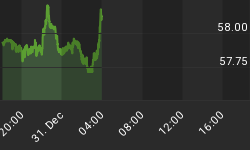The most important question for investors at this time is to determine how high interest rates will rise; if indeed the Fed's artificial suppression of yields is truly about to end. To accomplish this we first must consider where yields last were outside of central bank debt monetization, a recession and the Eurozone debt crisis. Then, we need to factor in the increased risks to inflation and solvency, in order to arrive at an appropriate estimation for the level of interest rates during 2014.
The last time there was; no QE is session, no flight to safety in U.S. Treasuries from European debt insolvency, and the economy was not contracting, was in the spring of 2010. During that time, the U.S. Ten Year Note offered a yield just below 4 percent. But it is not accurate to then assume that rates will just gradually rise back to where they were before all three conditions were in place. Here's why.
Credit Risks Have Increased
It is crucial to understand why the Fed's inflationary campaign will not succeed in bailing out the economy. The reason for this is while it is true that inflation makes easier for an over-indebted economy to pay down debt, it also (because of ultra-low low borrowing costs) tends to truncate the deleveraging process. And, if those low interest rates stay in place for a protracted period of time it causes the economy to become even more leveraged than it was prior to the crisis. This is precisely what we find today.
The proof for this can be found in the borrowing habits of corporations, consumers and the government after the credit crisis unfolded. It is true that immediately after the collapse of the real estate market, consumers and businesses began to pay down debt. However, the government immediately began piling on new debt in record fashion. Corporations then started to accumulate more debt in the spring of 2010. And consumers have now fully reversed course as well and are happily adding to their debt loads.
Thanks to the nearly-free money offered by the Fed during the past several years, publicly traded U.S. Treasury debt has soared by $4 trillion (46%) since the spring of 2010. Corporate debt has increased by $1.6 trillion (8.2%) during that same timeframe. And, in the third quarter of 2013 consumer debt jumped by $127 billion, to reach a total of $11.28 trillion -- the largest quarterly increase since Q1 2008. Household debt was up across the board with mortgage debt, auto loans, student loans and credit card balances all increasing substantially.
The significant increase in aggregate debt outstanding in the economy equates to a substantial increase in the credit risk of owning U.S. sovereign debt.
Inflation Risks Rising
The last time the 10-Year Note was trading at 4%, interest rates had been near zero percent for just over one year. Now, money has been nearly free for a total of five years. In addition, the size of the Fed's balance sheet has soared from $2.3 trillion, to just under $4 trillion (an increase of over 70%). The inflation risks in the economy have vastly increased given the facts that the supply of bank credit (high-powered money) is at an all-time record high, and at the same time the level of borrowing costs are at a record low.
So How High Will Rates Go?
The bottom line is the interest rates offered on sovereign debt are mostly a function of the credit and inflation risks associated with owning that debt--not the level of growth in the economy, no matter what Wall Street likes to claim. Given the above data, it is clear that the 4% yield on the Ten-Year Note seen back in early 2010 will be eclipsed. Since inflation pressures and the solvency risks to the nation have increased by an average of about 50%, it would seem logical to assume the Ten-Year Note should trade 50% higher than where it was back in early 2010. This would put the Ten-Year in the 6% range, which is still about 100 basis points below the forty-year average. Of course, this is providing the Fed is actually going to end its artificial manipulation of long-term interest rates next year.
Don't be Fooled by the Consensus
The overwhelming consensus on Wall Street is that the economy will slowly improve and the Fed's taper will cause that benchmark interest rate to rise gradually back towards 3.25% over the course of 2014, from its 2.83% level today. However, the real risk is that rates do not rise slowly and by a small increment. Don't forget, the Fed is has been buying 80% of all new Treasury debt, and it is a buyer that is totally indifferent to price.
A genuine attempt by the Fed to exit QE will cause interest rates to quickly soar back above 4%, and then perhaps as high as 6% in just a few months after the taper is concluded.
Therefore, it is prudent to assume the new Fed Chairman, Janet Yellen, will abort the tapering process shortly after it begins. That's because rapidly-rising interest rates would be devastating to real estate, equities and the overleveraged economy in general. The shock for Wall Street will be that the Fed reverses tapering its asset purchases and begins adding to the total amount of QE next year. This would mark a significant turning point for the dollar, international equities and commodities.
















